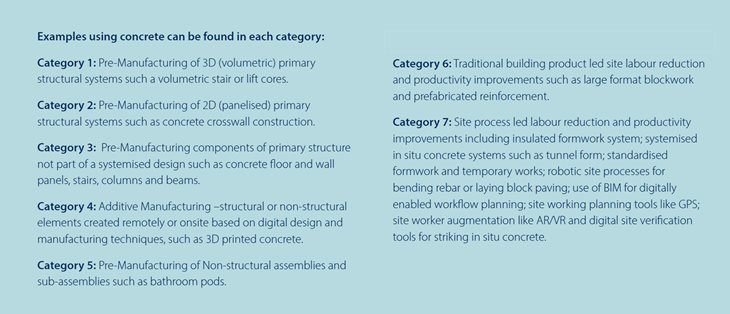Modern methods of construction (MMC)
The Modern Methods of Construction (MMC) definition framework was published by the Ministry of Housing, Communities and Local Government (MHCLG) in 2019. It categorised different forms of innovative construction methodologies aiming to regularise terminology within the sector and aide understanding and ultimately greater uptake of offsite manufacturing for construction. Of its seven categories, the first five are identified as off- or near-site pre-manufacturing and the last two relate to site-based process improvements.

The concrete industry embraces innovation and modern methods of construction (MMC) by offering concrete solutions which can be used to reduce construction time and promote sustainable development, as well as offering cost savings. More detail on a selection of systems available using concrete are provided below. See also ‘Offsite Concrete Construction’ publication.
Precast Flat Panel System
Floor and wall units are produced off-site in a factory and erected on-site to form robust structures, ideal for all repetitive cellular projects. Panels can include services, windows, doors and finishes. Building envelope panels with factory fitted insulation and decorative cladding can also be used as load-bearing elements. This offers factory quality and accuracy, together with speed of erection on-site. This type of construction is normally called crosswall construction and advice on the design can be found in The Concrete Centre’s publication Crosswall Construction. More detailed structural advice can be found in The Concrete Centre’s publication Residential Cellular Concrete Buildings.
3D Volumetric Construction
3D Volumetric construction (also known as modular construction) involves the production of three-dimensional units in controlled factory conditions prior to transportation to site. Modules can be brought to site in a variety of forms, ranging from a basic structure to one with all internal and external finishes and services installed, all ready for assembly. The casting of modules uses the benefits of factory conditions to create service-intensive units where a high degree of repetition and a need for rapid assembly on-site make its use highly desirable. Concrete stair and lift cores and bathroom pods fall into this category.
This modern method of construction offers the inherent benefits of concrete, such as thermal mass, sound and fire resistance, as well as offering factory quality and accuracy, together with speed of erection on-site.
Tunnel Form
Tunnel form is a formwork system that allows the contractor to build monolithic walls and slabs in one operation on a daily cycle. It combines the speed, quality and accuracy of factory/offsite produced ready-mixed concrete and formwork with the flexibility and economy of cast in-situ construction.
This fast-track method of construction is suitable for repetitive cellular projects, such as hotels, apartment blocks and student accommodation. It offers economy, speed, quality and accuracy, as well as utilising the inherent benefits of concrete, such as fire and sound resistance.
The formwork sections for tunnel form are large and need to be swung by crane out from the side of the building when the concrete is being struck. This means that it is not suitable for tight sites.
More detailed structural advice can be found in Residential Cellular Concrete Buildings published by The Concrete Centre.
Flat Slabs
Flat slabs are built quickly due to modern formwork being simplified and minimised. Rapid turnaround is achieved using a combination of early striking and panelised formwork systems. Use of prefabricated services can be maximised because of the uninterrupted service zones beneath the floor slab; so flat slab construction offers rapid overall construction, as it simplifies the installation of services.
In addition to saving on construction time, flat slab construction also places no restrictions on the positioning of horizontal services and partitions. This offers considerable flexibility to the occupier, who can easily alter internal layouts to accommodate changes in the use of the structure. Post-tensioning of flat slabs enables longer and thinner slabs, with less reinforcement, and hence offers significant programme and labour advantages.
Hybrid Concrete Construction
Hybrid concrete construction combines all the benefits of precasting with the advantages of cast in-situ construction. Combining the two, as a hybrid frame, results in even greater construction speed, quality and overall economy. Hybrid concrete construction can answer client demands for lower costs and higher quality by providing simple, buildable and competitive structures that offer consistent performance and quality.
Thin Joint Masonry
Thin Joint Masonry allows the depth of the mortar to be reduced from 10mm to just 3mm or less, resulting in faster laying and improved productivity, particularly on long runs of walling. Construction speed can be further increased by some 13.5 per cent using large-format concrete blocks, which have a face size equivalent to two traditional concrete blocks. The mortar cures rapidly, achieving full bond strength within one to two hours, eliminating the problem of 'floating' therefore enabling more courses to be laid per day.
Insulating Concrete Formwork
Insulating Concrete Formwork (ICF) systems consist of twin-walled, expanded polystyrene panels or blocks that are quickly built up to create formwork for the walls of a building. This formwork is then filled with factory produced, quality assured, ready-mixed concrete to create a robust structure. The expanded polystyrene blocks remain to provide high levels of thermal insulation and the concrete core provides robustness and good levels of sound insulation. More information on ICF is included in The Concrete Centre publication Insulating Concrete Formwork.
Precast Foundations
Precast concrete systems can be used to rapidly construct foundations. The elements are usually to a bespoke design and cast in a factory environment, giving assured quality for the finished product. The foundations are often supported by concrete piles and connected together.
These systems improve productivity, especially in adverse weather conditions, and reduces the amount of excavation required - particularly advantageous when dealing with contaminated ground.